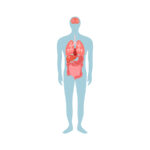By Bonnie Jenkins, Advanced Natural Wellness
Aching muscles, a fever, even the swelling around a paper cut are all signs of inflammation. This short-term type of inflammation is part of the body’s own first aid kit because it means your immune system is responding to injury and intruders, such as bacteria. But when inflammation becomes the norm instead of the exception, it’s time for concern.
Left untreated, chronic inflammation plays a role in all the diseases associated with getting older. Arthritis has long been the prime example of inflammation run amok. Now, inflammation has also been linked to heart disease, stroke, cancer, Alzheimer’s and asthma, just to name a few. Fortunately, there’s plenty you can do to tame and even prevent simmering inflammation from provoking these ailments.
Inflammation Nation
Sometimes inflammation is confined to where it first wreaks havoc. For instance, inflammation from untreated gastro esophageal reflux disease (GERD) can trigger esophageal cancer. But inflammation can also start in one area and then cause trouble in another. Inflamed gums caused by excessive bacteria in the mouth is a potential risk factor for heart disease and stroke.
While those are examples of problems you see or feel, it’s not always easy to detect degenerative inflammation without a blood test. Blood tests can spot elevated blood levels of C-reactive protein (CRP), interleukin 6 (IL-6) and tumor necrosis factor (TNF) – all red flags that signal inflammation.
Although, there’s not enough research yet on IL-6 and TNF to make it worthwhile to get those blood tests. But experts now recommend getting a CRP test when you get tested for elevated cholesterol levels. The gold standard is the high-sensitivity form of the test (hs-CRP). Here’s what hs-CRP levels mean for heart disease:
MD Exposes the Hidden Danger to Your Eyes

When your eyesight starts to fail, it's a real problem. Suddenly you can't go to the grocery store... you can't get to the doctor if you have an emergency... you can't meet your friends for dinner…
Your "regular" doctor doesn't have time to keep up with the latest research. And the same goes for eye doctors. They go to school to learn how to fit you for glasses and contacts, but have no way of preventing the damage and loss of eyesight that threatens your freedom and independence.
Let me show you something that explains a LOT about how your eyes work.
In my FREE Special Report, I'll show you a HUGE, untapped resource for your eyes that safely and naturally restores clear, effortless eyesight.
Click here to get started...
Low risk = less than 1.0 milligram per liter
Average risk = 1.0 to 3.0 milligrams per liter
High risk = more than 3.0 milligrams per liter
Dead Weight
So what can cause these markers to rise? Excessive body fat typically translates into higher levels of CRP, IL-6 and perhaps TNF in the blood stream, suggesting that obesity triggers inflammation. Researchers already know that inflammation promotes insulin resistance, which leads to type 2 diabetes. Insulin resistance has also been linked to Alzheimer’s disease.
The good news is that simply losing weight can reverse all of these dangerous trends. Researchers at the University of Vermont studied overweight middle-aged women and found the more weight a woman lost, the more her CRP fell, 32 percent on average.
Regular physical activity – at least 30 minutes most days of the week – helps control weight and calms inflammation. A study from Emory University School of Medicine found that people who exercised more than 22 times a month had significantly lower CRP levels than those who worked out fewer than three times monthly. More recently, Korean researchers discovered that people who didn’t exercise regularly were more prone to belly fat with a higher amount of underlying visceral fat – a combination that is strongly associated with high blood levels of CRP, insulin resistance and endothelial dysfunction.
Fat Facts
When you think about losing weight to reign in inflammation, you probably don’t think eating fat is a smart move. But you would be wrong! Consuming the right type of fat can go a long way toward preventing or reducing inflammation. Eating fatty fish like salmon or mackerel has been linked to lower inflammation indicators and less arthritis pain in some clinical studies. (The omega-3 fatty acids in fish can reduce CRP and TNF.) But unless you eat fish two to three times a week, it’s a good idea to supplement with a high quality marine lipid fish oil supplement. The typical dose is 3,000 to 4,000 IU daily. As a bonus, supplemental fish oil also helps lower triglycerides.
Extra-virgin olive oil also has impressive anti-inflammatory properties. Research shows that the highest quality olive oil offers beneficial levels of oleocanthal, a compound that acts like a natural anti-inflammatory, actually mimicking the effects of ibuprofen.
Of course, not all dietary fats are good for you. Trans fat found in some cookies, crackers and stick margarine promotes inflammation and may be particularly problematic. Research has uncovered a link between elevated levels of trans fatty acids in red blood cells and inflammation in people with chronic heart failure. All the more reason to avoid this unhealthy fat.
The World's Quickest Solution for Ending Prostate and Urinary Misery
This has recently been revealed to be one of the only real breakthroughs in prostate health.
The seeds of a strange fruit (sometimes called "Chinese Apples") hold powerful phytonutrients that are a revolution in prostate health.
In fact, UCLA and Veterans Administration research have now proved this to be true.
Not only that, but it may be the worlds quickest solution for ending prostate misery.
Simply stated, these phytonutrients represent a huge step beyond beta sitosterol, saw palmetto, and other phytosterols alone.
Simply click HERE if you want to have fast prostate relief...restful, uninterrupted sleep...no more constant "urges to go"...enhanced virility...and optimal prostate support for life.
Out of India
Ayurvedic medicine has long held the answer to taming inflammation. Boswellia, for instance, is an ayurvedic herb that prevents inflammation by binding to the COX-2 enzyme. In one study, patients suffering from knee arthritis experienced less pain and swelling, more flexibility and were able to walk further after taking boswellia for eight weeks. Best of all, this herb is incredibly safe.
In patients with rheumatoid arthritis and Crohn’s disease, boswellia can help reduce the immune cells that promote inflammation while increasing the number anti-inflammatory cells. In studies of patients with inflammatory bowel disease, ulcerative colitis and Crohn’s disease boswellia reduced gastrointestinal inflammation and tissue damage.
Another safe and effective herb is the curry spice tumeric, which helps prevent inflammatory damage on a cellular level. Tumeric contains curcumin, the natural pigment that accounts for the spice’s deep yellow color. But curcumin is also a powerful antioxidant and anti-inflammatory. For chronic inflammation, consume at least ½ teaspoon of the spice daily. If you aren’t a fan of curry, you can also take up to 2,800 mg. of a good quality tumeric supplement daily.
One Last Thing . . .
Inflammation has also been linked to the development of certain types of cancer – especially colon, prostate, testicular and lung cancers. One way researchers think that chronic inflammation contributes to cancer is by promoting tumor growth. Another possibility is that the spread of cancer is fostered by eicosanoids – immune system chemicals that can trigger inflammation.
Although scientists haven’t uncovered the exact mechanism, one thing is clear – when it comes to cancer, chronic low-level inflammation makes a bad situation a whole lot worse. But there is an easy way to eat away the risk for inflammatory-induced cancer.
Fresh fruits and vegetables are rich in antioxidants that tame inflammation. Among the best are pomegranates, blueberries, cranberries, beans, artichokes and Russet potatoes. Green and white teas are also antioxidant-rich powerhouses. And don’t forget seasonings! Ground cloves, cinnamon and oregano were the top three antioxidant-rich spices.
What foods should you avoid? Refined carbohydrates like white sugar and white flour as well as dairy foods. One of the worst inflammation triggers is red meat. That nice juicy steak contains high levels of arachidonic acid that can increase pro-inflammatory eicosanoids.
This Just In . . .
Because it’s an election year – and John McCain is not only a candidate for president, but a two-time cancer survivor – the media has focused more closely on the hazards of skin cancer. But, while untreated melanoma can lead to death, new evidence indicates that non-melanoma skin cancers may also have a deadlier side than previously known.
A new study by researchers at the Medical University of South Carolina has established a link between non-melanoma skin cancer and a higher susceptibility to other types of cancer. The USC team analyzed data from an ongoing cancer study called CLUE II. The researchers compared the risk of malignancies in participants who had been diagnosed with non-melanoma skin cancer with individuals with no history of the disease during a 16-year follow-up period.
Those who had a personal history of basal cell carcinoma and squamous cell carcinoma had double the risk of developing a subsequent malignancy. The researchers suspect that these folks have a genetic predisposition to cancer – and that their bout with skin cancer may be an early warning.
What does this mean to you? If you or a close family member has battled non-malignant skin cancer, it’s probably smart to practice cancer prevention – don’t smoke, protect yourself from the sun, eat a healthy diet filled with antioxidants, take a multi-vitamin, exercise and swap the soda for green tea. While there isn’t much we can do about our genes, the lifestyle choices we make really can make all the difference.
References:
Calder PC. “Polyunsaturated fatty acids, inflammatory processes and inflammatory bowel diseases.” Molecular Nutrition and Food Research. 2008;52:885-897.
Chen J, Ruczinski I, Jorgensen TJ, et al. “Nonmelanoma Skin Cancer and Risk for Subsequent Malignancy.” Journal of the National Cancer Institute Advance Access published online on August 26, 2008.
Kim K, Valentine RJ, Shin Y, et al. “Associations of visceral adiposity and exercise participation with C-reactive protein, insulin resistance, and endothelial dysfunction in Korean healthy adults.” Metabolism. 2008;57:1181-1119.
Tchernof A, Nolan A, Sites CK, et al. “Weight loss reduces C-reactive protein levels in obese postmenopausal women.” Circulation. 2002;105:564-569





